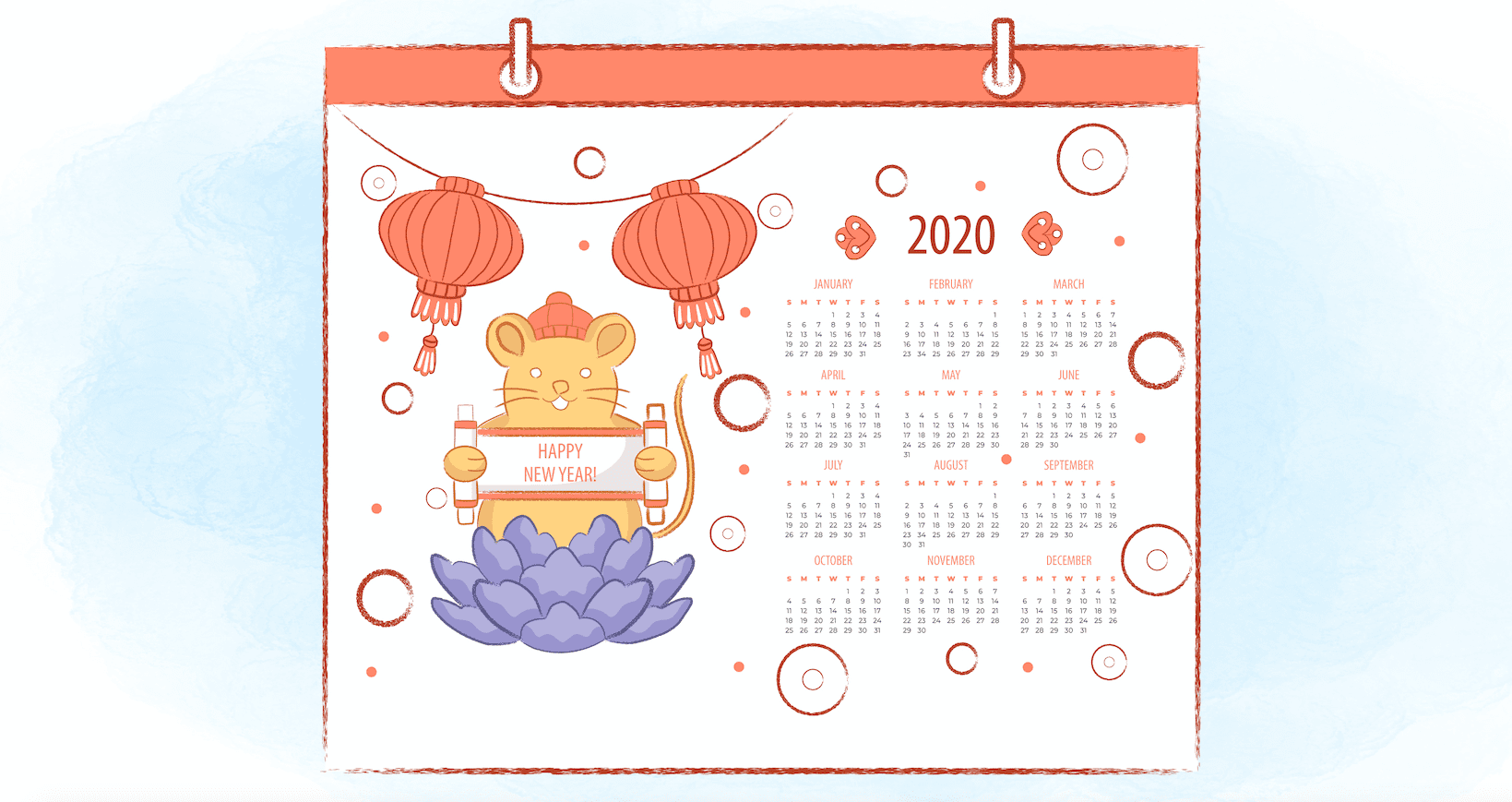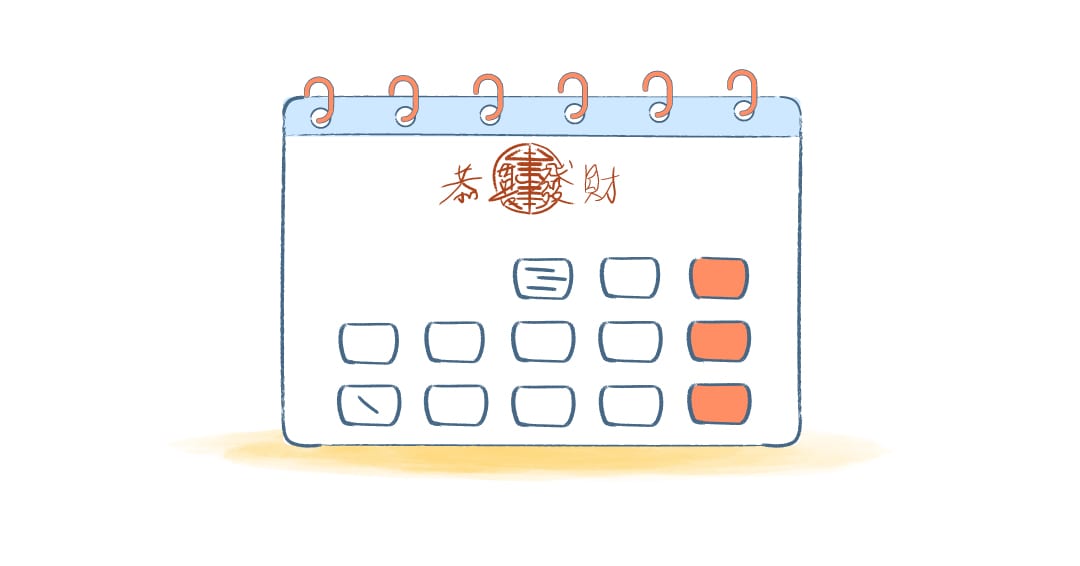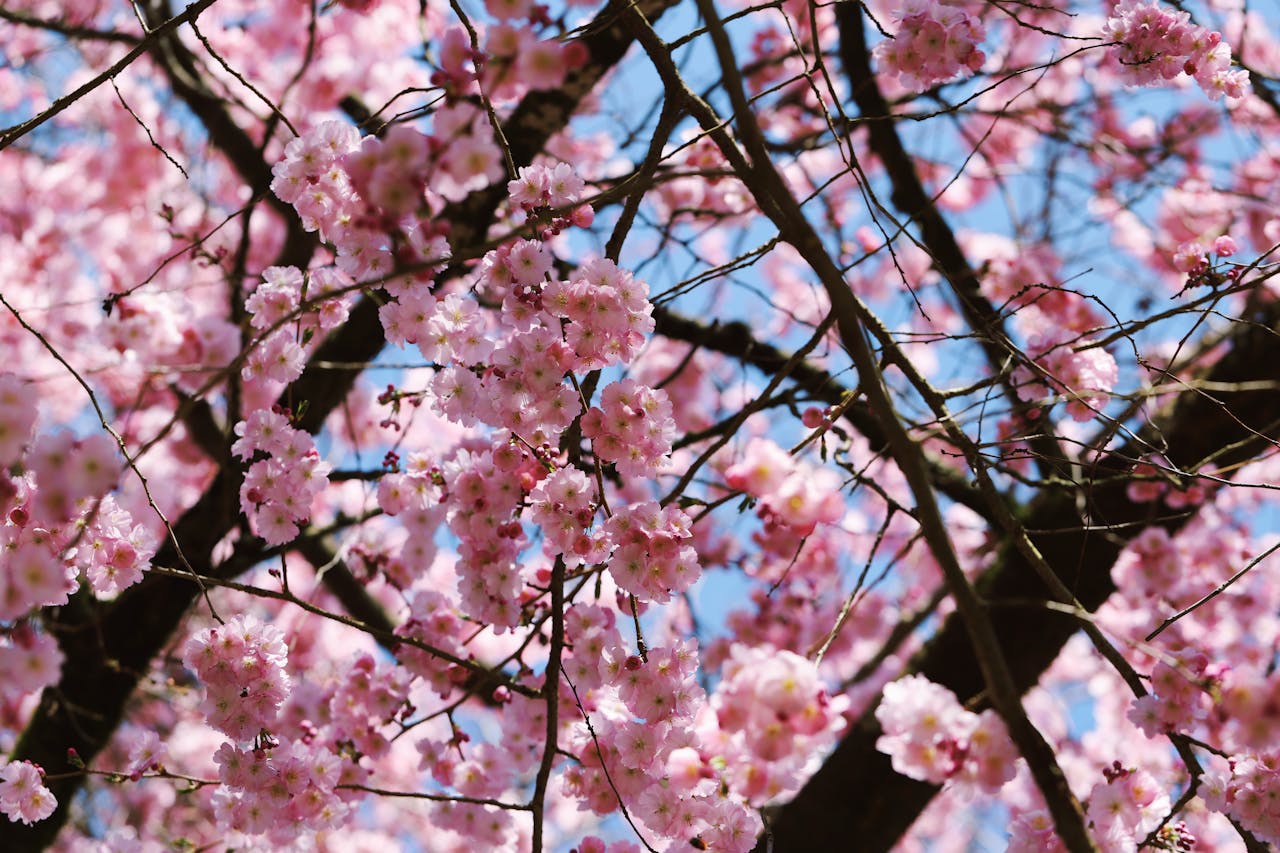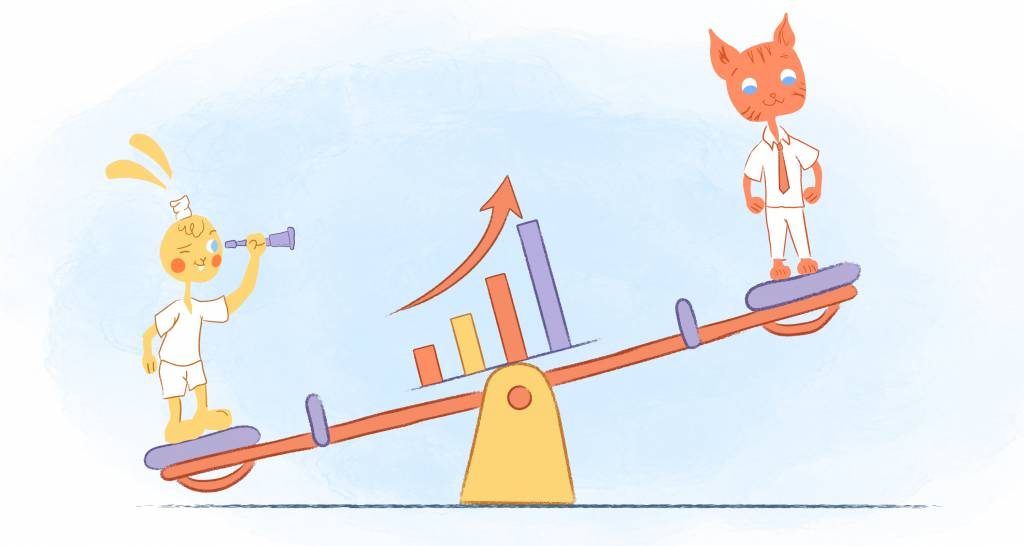

What is the Chinese Calendar?
The Chinese calendar, like the Hebrew calendar, is a lunisolar calendar. As defined by the Oxford Dictionary, a lunisolar calendar is when a calendar year is divided “according to the phases of the moon, but adjusted in average length to fit the length of the solar cycle.”
For those unfamiliar with this type of calendar, it may sound complicated. However, a typical year is still 12 months, while leap years have 13 months. An ordinary year in the Chinese calendar has 353, 354, or 355 days. However, a leap year has 383, 384, or 385 days.
A Chinese calendar month will always have 29 or 30 days. The reasoning for 29-30 days is because (as explained in China Highlights), this is because the “calendar is based on lunar cycles or phases of the moon. Chinese months begin with a new moon and have a full moon on day 15. As a new moon comes roughly every 29½ days.”
Determining what a Chinese calendar looks like.
Definitive information about what the Chinese calendar is going to look like requires some astronomical calculations. Thankfully, the team over on the online museum WebExhibits has already broken the design and look down for us.
The first step is to find out the dates for the new moons. For a Chinese Calendar, this would be a completely “black” moon — meaning “the moon is in conjunction with the sun” — and not the “first visible crescent” that are used in both the Islamic and Hebrew calendars. “The date of a new moon is the first day of a new month.”
Next, “determine the dates when the sun’s longitude is a multiple of 30 degrees. (The sun’s longitude is 0 at Vernal Equinox, 90 at Summer Solstice, 180 at Autumnal Equinox, and 270 at Winter Solstice.)”
These dates are known as the Principal Terms and needed to figure out the number of each month. For example, Principal Term 1 takes place when the sun’s longitude is 330 degrees, the second occurs when the sun’s longitude is 0 degrees, the third when the sun’s longitude is 30 degrees, and so forth.
“Each month carries the number of the Principal Term that occurs in that month,” adds WebExbihits. And, there are also rare cases when a month could have two Principal Terms.
Keep in mind that “the astronomical calculations are carried out for the meridian 120 degrees east of Greenwich. The Greenwich timezone roughly corresponds to the east coast of China.”


Chinese-Calendar
What about leap years?
As mentioned above, leap years have 13 months. But, how can you determine if a specific year is a leap year?
To begin, you’ll have to calculate the number of moons between the 11th month in one year, this would be the month that contains the Winter Solstice, and the 11th month for the following year. If you discovered that there 13 moons during this period, then a leap month must be added.
It should also be noted that in leap years, at least one of the months cannot contain a Principal Term. “The first such month is the leap month. It carries the same number as the previous month, with the additional note that it is the leap month,” explains WebExhibits.
Rules of the Chinese Calendar
To better understand how the Chinese calendar works, here are the rules that have been in place since c. 104 B.C.E.:
- Because the months are lunar-months, the first day of each month beginning at midnight is the day of the astronomical new moon. However, a “day” starts at 11 P.M.
- There 12 regular months and are numbered in sequence (1 to 12). They also have alternative names. And, every second or third year has an intercalary month that proceeds any regular month. While the regular-months have the same number as the preceding regular-months, it’s designated intercalary.
- Every other jiéqì of the Chinese solar year is equivalent to an entry of the sun into a sign of the tropical zodiac (a principal term or cusp).
- During month 11, the sun always passes through the winter solstice.
- If there are 12 months between two successive occurrences of month 11, one of them must be a month where the sun remains in the same zodiac sign. In other words, no key term or cusp occurs. If this happens, it is considered intercalary. If two such months occur, then only the first is deemed to be intercalary.
- Times of the astronomical new moons, as well as when the sun enters a zodiac sign, are determined in the Chinese Time Zone by the Purple Mountain Observatory.
- The date on the Chinese calendar can be from 15 days behind to 15 days in front of the traditional solar calendar. As such, it’s between 21 to 51 days behind the corresponding Gregorian calendar date.
- The Chinese New Year takes place on the first day of the first lunar month.
Counting the Years and the 60-Year Cycle
The Chinese calendar is unique in that it does not count years in an infinite sequence. Instead, each year has been assigned a name that repeats every 60 years. This 60-year cycle is also broken into two components.
The celestial storm.
The first is a celestial storm. Here are the celestial storm names and what the names are associated with:
- Jia (growing wood).
- Yi (cutting timber).
- Bing (natural fire).
- Ding (artificial fire).
- Wu (earth).
- Ji (earthenware).
- Geng (metal).
- Xin (wrought metal).
- Ren (running water).
- Gui (standing water).
The Terrestrial Branch.
The second component is the Terrestrial Branch. These contain the names of animals in a zodiac cycle and consist of the following 12 animals. We’ve also included the years associated with each animal. It’s believed that if you would take on the personality traits of the animal representing the year you were born.
- Zi (Rat): 1960, 1972, 1984, 1996, 2008, 2020.
- Chou (Ox): 1961, 1973, 1985, 1997, 2009.
- Yin (Tiger): 1962, 1974, 1986, 1998, 2010.
- Mao (Rabbit): 1963, 1975, 1987, 1999, 2011.
- Chen (Dragon): 1964, 1976, 1988, 2000, 2012.
- Si (Snake): 1965, 1977, 1989, 2001, 2013.
- Wu (Horse): 1966, 1978, 1990, 2002.
- Wei (Sheep): 1967, 1979, 1991, 2003.
- Shen (Monkey): 1968, 1980, 1992, 2004.
- You (Rooster): 1969, 1981, 1993, 2005.
- Xu (Dog): 1958, 1970, 1982, 1994, 2006.
- Hai (Boar/pig): 1959, 1971, 1983, 1995, 2007, 2019.
Legend has it that a race across a river determined the sequence of the animals in the calendar.
The two components are used sequentially. That would mean that the 1st year of the 60-year cycle becomes jia-zi, the 2nd year is yi-chou, the 3rd year is bing-yin, and so forth. At the end of a component, everything restarts from the beginning: “The 10th year is gui-you, the 11th year is jia-xu (restarting the Celestial Stem), the 12th year is yi-hai, and the 13th year is bing-zi (restarting the Terrestrial Branch). Finally, the 60th year becomes gu,” explains WebExhibits
The naming of years within this 60-year cycle dates back to approximately 2000 years. And, while the similar naming of days and months is no longer in fashion, the date name remains listed in calendars.
It’s also customary to number the 60-year cycles since 2637 B.C.E. since this was when the calendar was started or invented.
The 24 Solar Terms of the Chinese Calendar
If you recall, Chinese months follow the phases of the moon. However, this means that it does not follow the seasons of the solar year. And, this was a problem for farmers. To assist them in determining when it was best to plant and harvest crops, 24 seasonal markers, called jiéqì, were placed onto the calendar. These nodes of weather occur when the sun reaches one of the 24 equally spaced points along the ecliptic.
Here are those solar terms accompanied by the degree of the ecliptic longitude and the date on the Gregorian calendar.
Chinese calendar terms.
- Start of Spring: Known as lì chūn, this takes place around February 4 or at 315° ecliptic longitude.
- Rain Water: Called yǔ shuǐ, occurs at 330° or February 19.
- Awakening of insects: jīng zhé happens at 345° or March 5.
- Vernal Equinox: chūnfēn is at zero degrees or March 21.
- Clear and Bright: qīng míng is on April 5 or 15°.
- Grain Rain: gǔ yǔ is at 30° or April 20.
- Start of Summer: lìxià occurs on May 5 or 5 and at 45°.
- Small Full (Grain): xiǎomǎn is at 60° or May 21.
- Grain in Ear: máng zhǒng on June 6 or 75°.
- Summer Solstice: xià zhì is at 90° or on June 21.
- Minor Heat: xiǎo shǔ occurs on July 7or at 105°.
- Major Heat: dà shǔ is around July 21 or 23 or at 120°.
- Start of Autumn: lìqiū is on August 7 or at 135°.
- Limit of Heat: chù shǔ is at 150° or August 23.
- White Dew: bái lù on September 8 or 165°.
- Autumnal Equinox: qiūfēn at 180° or roughly September 23.
- Cold Dew: hánlù on October 8 or at 195°
- Frost Descent: shuāngjiàng at 210° or on October 23.
- Start of Winter: lìdōng at 225° and around November 7.
- Minor Snow: iǎoxuě occurs approximately on November 22 or 240°.
- Major Snow: dàxuě is around December 7 or 255°.
- Winter Solstice: dōngzhì is on December 22 and at 270°.
- Minor Cold: xiǎohán is at 285° or January 6.
- Major Cold: dàhán is at 300° or January 20.
Brief History of the Chinese Calendar
The origins of the Chinese calendar can be traced back to the 14th Century BC, which was during the Shang Dynasty. The reason we know this is because oracle bone inspections were discovered from this time period. These inscriptions established the solar year at 365¼ days and lunation at 29½ days. In the calendar that the Shang used. We also know that this was a lunisolar calendar since it contained the intercalation of lunar months.
Initially, the start of the year occurred at a New Moon near the winter solstice. However, there was a significant calendar reform during the late second century B.C.E. that required the winter solstice to occur in month 11 — this is still true today. Over the years, each dynasty made their own modifications to the calendar. The additions and modifications of the Chinese Calendar were thanks in part to advancements in astronomy and mathematics.
Many believe that it was the Emperor Huangdi (Huang Ti or Huang Di) who introduced the calendar somewhere between 3000 and 2600 BCE — to be exact, it was around 2637 BCE. His minister Ta Nao is often credited for preparing the first calendar, which was called the Chia-Tzu or Kan-Chih system. This can be translated to “the system of cyclical characters.”
During the Zhan Guo period in the 5th century B.C., another phase was added to the calendar so that it could be used for widespread use. It was during the fifth century B.C. when the twelve animals associated with each year during the Chou period were introduced and still commonly used today.
The Chinese calendar, known as the Taichu (or Taichung) calendar that’s still used today, first appeared in 104 BC during the rule of Emperor Wu of the Han Dynasty.
Introduction of the Gregorian calendar.
Although first brought to China by Jesuit missionaries in 1582, the country resisted the Gregorian calendar until 1912. However, it was not widely used until the Communist victory in 1949. It actually took place on October 1, 1949, when Mao Zedong ordered that the year should be in accord with the Gregorian calendar.
The Relevance of the Chinese Calendar Today
Like in most countries around the world, China now uses Gregorian today for daily activities like scheduling tasks and events. However, it did influence other calendars in the past. For example, the Korean calendar is precisely identical. As for today, the Chinese calendar is used primarily for noting traditional holidays and festivals. This is particularly true for important events and festivals. These include the Chinese New Year, Lantern Festival, Boat Dragon Festival, Night of Sevens, Ghost Festival, Mid-Autumn Festival, and the Winter Solstice Festival.
What’s more, people use the calendar to select ‘lucky dates’ for meaningful events like weddings, funerals, and even business deals. There’s actually a special calendar called Huang Li that is used for times and activities for those specific dates. While the special calendar uses the Gregorian dates — Huang Li still corresponds to the traditional Chinese dates listed on the calendar.











Deanna Ritchie
Editor-in-Chief at Calendar. Former Editor-in-Chief and writer at Startup Grind. Freelance editor at Entrepreneur.com. Deanna loves to help build startups, and guide them to discover the business value of their online content and social media marketing.